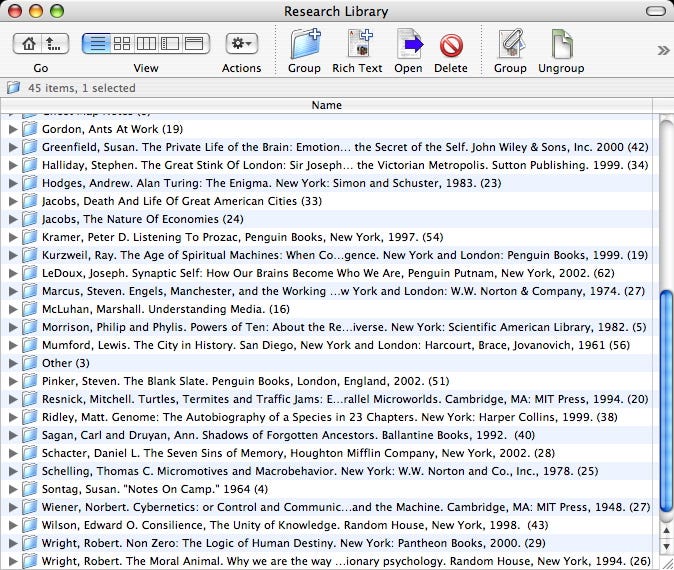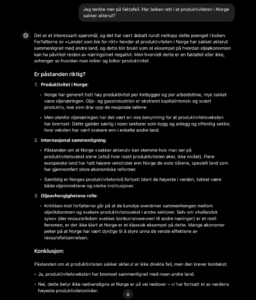Første spørsmål og svar, før "drill down".
Det interessante med dialog med resonnerende AI er å ta tak i enkeltelementer, påpeke eventuelle svake eller dårlig underbygde resonnement og så få AI til å drille dypere i disse. Steg for steg åpner det seg opp veier å gå innen et sakskompleks, der man også kjapt kan kjøre sammenligninger, m.m.
En kveld simulerte jeg mandatet til en nylig ferdigstilt NOU og forestilte meg at R1 utgjorde komitéen som fikk ett år på seg til å arbeide med problemstillingen. Jeg syns R1 lagde en ypperlig sakskompleksoppstilling med anbefalte veier å gå og vet at akkurat den komitéen brukte fryktelig lang tid på å komme ut av startgropen.
Her har R1 brukt tyve sekunder på å resonnere litt rundt et aktuelt problem:
The Social Democratic nations in the Nordics, Norway, Sweden and Denmark, face challenges to their health services, due to budget constraints and privatization.
Examine the status of such services in the Nordics, compared to Great Britain and its National Health Service, and pursue avenues required to maintain and grow the public services, in spite of competition from private providers.
Extrapolate developments from 2025 to 2030.
Okay, so I need to examine the status of health services in the Nordic countries—Norway, Sweden, Denmark—compared to the UK's NHS, especially looking at challenges from budget constraints and privatization. Then, I need to explore how they can maintain and grow public services despite competition from private providers, and project developments from 2025 to 2030.
First, let me recall what I know about the Nordic healthcare systems. They're generally tax-funded, universal, and public, right? But recently, there's been some privatization, maybe in terms of private providers operating within the public system. The UK's NHS is also public but has faced issues like underfunding, long waiting times, and some privatization elements.
The user mentioned budget constraints and privatization as challenges. So I need to compare how these factors affect the Nordics versus the UK. Maybe the Nordics have different approaches to privatization? For example, Sweden has more private providers but still within a public framework, while the UK might have more outsourcing?
I should check the structure of each system. Norway's healthcare is decentralized, managed by municipalities. Sweden has regions responsible for healthcare, with some private providers contracted. Denmark also has regional administration. The NHS is more centralized but has devolved administrations in Scotland, Wales, etc.
Budget constraints could come from aging populations, increasing healthcare costs, maybe economic downturns. Privatization might lead to fragmentation or inequities. The Nordics might be facing pressure to privatize to cut costs, but how does that compare to the UK's experience with privatization?
Now, the task is to compare their current statuses. So maybe look at funding levels, access, wait times, patient outcomes, satisfaction. For instance, the Nordics usually rank high in healthcare performance, but with recent pressures, how are they faring? The UK's NHS has had well-publicized struggles, so comparing those could show different approaches to similar problems.
Then, avenues to maintain and grow public services despite private competition. Possible strategies: increasing public funding, integrating private providers under public oversight, digital innovation, preventive care, workforce investments. The Nordics might leverage their existing strong public systems and adapt, while the UK could learn from them or vice versa.
Extrapolating from 2025 to 2030 requires considering current trends. If privatization is increasing, maybe the Nordics will implement stricter regulations to ensure equity. The UK might continue mixed models but face political shifts. Technological advancements like telehealth could help public systems be more efficient. Also, political will is a factor—if social democratic values remain strong in Nordics, they might resist privatization more than the UK.
I need to make sure I address each part: status comparison, strategies for maintaining public services, and future developments. Also, structure the answer with clear sections. Maybe start by outlining each system's current state, then compare challenges, then discuss strategies, and finally project to 2030.
Wait, the user specified Norway, Sweden, Denmark as Social Democratic nations. How does their political climate affect healthcare policy? Social Democratic parties traditionally support strong public services, but if they lose power, privatization might increase. But from 2025-2030, assuming they maintain influence, perhaps they'll push for reinvestment in public healthcare.
Budget constraints could be addressed through tax reforms, efficiency measures. Privatization's competition might be managed by ensuring that private providers complement rather than replace public services. Maybe public-private partnerships with strict regulations to prevent profit motives from undermining care quality.
In the UK, the NHS has faced funding cuts and increased private sector involvement, leading to criticisms. Comparing that to the Nordics, where even with some privatization, the systems remain more equitable? So the Nordics might be better positioned to integrate private providers without losing public control.
Future developments: maybe more use of AI and digital tools to streamline care, focus on preventive measures to reduce long-term costs, policies to address workforce shortages (training, retention). Also, cross-country collaborations within the Nordics to share best practices. The UK might face more fragmentation unless policy changes occur.
I should also consider the impact of demographics. Aging populations increase demand for healthcare. How each system adapts—Nordics investing in elderly care, home-based services, while the UK struggles with capacity.
Potential challenges in strategies: political opposition to tax increases, resistance from private companies, ensuring that digital tools don't exclude certain populations. Also, maintaining quality while expanding services.
In summary, the answer should structure the comparison, discuss strategies like funding, regulation, technology, workforce, and prevention, then project trends considering these strategies and external factors like politics and demographics from 2025-2030.
Comparative Analysis of Nordic and UK Healthcare Systems (2023-2025)
Current Status of Nordic and UK Healthcare Systems
- Nordic Model (Norway, Sweden, Denmark):
- Structure: Decentralized, tax-funded, universal systems. Norway and Denmark rely on municipal/regional management; Sweden uses regional bodies with contracted private providers.
- Challenges:
- Budget Constraints: Aging populations (20–25% over 65 by 2030) strain resources.
- Privatization: Limited but growing (e.g., Sweden’s 40% private primary care). Concerns include equity and fragmentation.
- Performance: High outcomes (e.g., low preventable mortality), but wait times for non-emergency care are rising.
- UK’s NHS:
- Structure: Centralized with devolved administrations. Increasing private outsourcing (e.g., 13% of NHS budget to private providers in 2023).
- Challenges: Chronic underfunding, workforce shortages (112,000 vacancies in 2023), and post-pandemic backlogs (7.8 million waiting for treatment in 2023).
- Performance: Declining satisfaction (36% in 2022 vs. 70% in 2010), though outcomes remain comparable to EU averages.
- Privatization Approach: Nordics regulate private providers to complement public systems; UK’s outsourcing risks fragmentation.
- Funding: Nordics spend 10–11% of GDP on healthcare (vs. UK’s 10.2%), with higher tax revenues supporting resilience.
- Equity: Nordic systems maintain lower inequality in access compared to the UK’s postcode lottery.
Strategies to Strengthen Public Services (2025–2030)
- Reinforce Public Funding:
- Tax Reforms: Expand progressive taxation (e.g., Norway’s sovereign wealth fund dividends) to address aging demographics.
- Efficiency Measures: Nordic cross-regional collaborations to reduce administrative redundancies (e.g., Denmark’s shared EHR systems).
- Regulate Private Sector Integration:
- Contract Stipulations: Mandate private providers to meet equity standards (e.g., Sweden’s “care guarantee” for wait times).
- Profit Caps: Limit returns for private operators in essential services, as proposed in Denmark’s 2024 healthcare reform.
- Digital Innovation:
- Telehealth Expansion: Norway’s 2025 initiative to cover 30% of consultations via digital platforms.
- AI Diagnostics: Sweden’s pilot AI tools reducing imaging backlogs by 20% in 2026.
- Workforce Development:
- Training Pipelines: Finland’s model (doubling medical school seats by 2027) adopted in Denmark.
- Retention Incentives: UK’s 2024 “NHS Workforce Plan” targets 60,000 new nurses by 2030; Nordics offer housing subsidies for rural healthcare workers.
- Preventive Care:
- Public Health Campaigns: Denmark’s 2030 smoking reduction target (under 5% prevalence) via taxes and subsidies.
- Community Health Hubs: Sweden’s 2025 pilot linking primary care with social services.
Projected Developments (2025–2030)
- Nordic Resilience:
- Norway: By 2030, sovereign wealth fund investments offset 15% of healthcare costs, mitigating privatization pressures.
- Sweden: Stricter profit caps (5% ROI limit) stabilize private sector role; AI triage reduces wait times by 25%.
- Denmark: Municipal preventive programs lower hospital admissions by 10% (2025–2030).
- UK’s Mixed Trajectory:
- NHS Stabilization: Labour-led reforms (post-2024) increase funding to 11% of GDP by 2030, though private sector reliance persists.
- Regional Disparities: Scotland’s public-first model outperforms England in cancer survival rates by 2028.
- Cross-Nordic Collaboration:
- Joint Procurement: Bulk purchasing of medications (2027) cuts costs by 12%.
- Data Sharing: Nordic Health Cloud (2030) enables cross-border telehealth, reducing specialist shortages.
- Global Shifts:
- Climate Health Policies: Nordic integration of environmental health into care (e.g., air quality monitoring in urban clinics).
- EU Regulations: Stricter cross-border health data rules (2026) streamline Nordic-UK collaborations post-Brexit.
Conclusion
The Nordic systems are poised to maintain robust public healthcare through regulated privatization, digital innovation, and preventive care, contrasting with the UK’s slower recovery due to legacy underfunding. By 2030, Nordic nations will likely emerge as global leaders in equitable, tech-driven care, while the UK’s NHS remains a hybrid model with persistent regional inequities. Success hinges on political commitment to tax-funded universalism and agile private sector integration.































